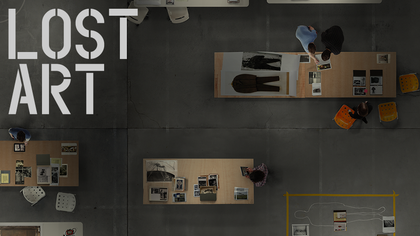Partially Buried Woodshed 1970
Robert Smithson made Partially Buried Woodshed in the grounds of Kent State University, Ohio, in January 1970. The American conceptual artist had been invited to the university for a one-week residency and, while there, created this work with the help of students.
The work consisted of an old woodshed that was partially buried on one side by twenty truckloads of earth, piled around and onto the structure until its central roof beam cracked. Smithson intended the shed to break up slowly under the weight of the earth, and vegetation to grow over the mound; and he wanted the university to take appropriate care of the artwork and the surrounding site until this process had run its course. He once said he hoped the piece would not only go on to decay but also would acquire ‘its own history’.
Partially Buried Woodshed would have continued on its slow path of collapse without much further publicity but for a tragic incident. On 30 April President Nixon, who had been elected on the promise of reducing America’s involvement in the Vietnam war, announced on national television and radio that American troops would attack Viet Cong bases in Cambodia, a country that had been ostensibly neutral throughout the conflict. During a student protest on 4 May at Kent State University, National Guard soldiers fired on unarmed students. Sixty-seven bullets were discharged in thirteen seconds, killing four and wounding nine. The Kent State shootings, as they became known, sparked a round of student strikes and demonstrations, both violent and non-violent, across the nation, and dramatically helped shift public opinion against the continuation of the war in Vietnam.
Shortly afterwards the words ‘MAY 4 KENT 70’ were painted onto the woodshed in bold white letters. Suddenly, the work became an unofficial memorial to the event, much visited by students. Some saw Smithson’s artwork as expressive of a malaise within American political society, the envisaged cracking of the roof beam by the overwhelming force of gravity serving as a metaphor for the breaking of the political system.
In later years the question of what to do with the artwork became a topic of often heated controversy. Planning to redevelop the area and create a new major public entrance near to the woodshed, the university found the work and its unofficial memorialisation of the shooting embarrassing, but others defended the right of Smithson’s increasingly famous work to remain untouched, no matter how unsightly it became. In 1982 the woodshed’s central beam finally broke, and from time to time groundsmen cleared up and took away loose timbers. By early 1984 someone – it is not known who or by whose order – cleared the site completely, removing all the remaining timber and leaving only the concrete foundation of two of the shed’s walls.
One of the few examples of land art by Smithson in the US had been lost, almost casually. Some felt that the piece was intended to disappear eventually, but others regretted the loss of a work that had acquired, as Smithson had hoped, a special significance or history.
This article was updated on 11 October 2012 with the correct date for the artwork

